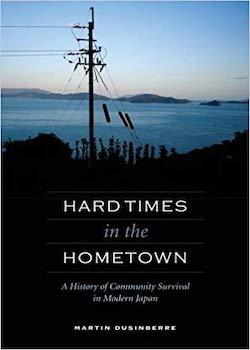Hard Times in the Hometown, A History of Community Survival in Modern Japan

By Martin Dusinberre
University of Hawaii Press, 2012,
247 pages including index, notes and bibliography,
ISBN 978-0-8248-3524-8
Review by Sir Hugh Cortazzi
Martin Dusinberre first went to Kaminoseki, the subject of this book, as an English language teacher. He found the town of great interest and returned there to undertake sociological research.
In this well researched book he traces the history of the town and reviews its problems in the 21st century. Kaminoseki lies on the shore of the Inland Sea in what was the Chõshû domain [長州藩] and is now part of Yamaguchi prefecture. Hiroshima is not so far away. Kaminoseki (literarily the upper barrier -上関) was the counterpart in the Edo period of Shimonoseki (literally the lower barrier). Both were important ‘guard’ posts on the route from Nagasaki to Edo and were accordingly stopping places for the ambassadors from Nagasaki to the Shogun’s court in Edo. Among these ambassadors were Korean envoys as well as the regular Dutch missions. So Kaminoseki was visited by such famous scholars as Engelbert Kaempfer and Carl Peter Thunberg when they accompanied the Dutch factor [chief executive officer] on his way to Edo to present his gifts to the Shogun. Robert Fortune, the plant collector, called there on the steamship England in 1860.
Fortunately for Dusinberre many of the town’s records have been preserved although sifting through them was a complicated and difficult process. His book follows the growth of the town and its subsequent economic decline. In some respects Kaminoseki was typical of other rural and coastal towns. In other ways it was different not least because of its position on the route through the Inland Sea to Edo.
During the Edo period the Chõshû fief, whose headquarters were in Hagi [萩], maintained significant facilities in Kaminoseki including a large official guest house. In the early nineteenth century Kaminoseki had become an important trading centre where small Japanese wooden ships were being built. By the middle of the century the port was dominating the village and the regional economy and providing non-agricultural employment. But from 1860 onwards steamships predominated and the port’s importance declined.
Agriculture for which the land was poorly suited and fishing in the waters of the Inland Sea could not provide adequate employment for the population which grew quickly after the Meiji Restoration. Many left for the cities which developed with Japan’s modernization. Others joined the flow of Japanese emigrants to Hawai’i and other places which welcomed Japanese immigrants.
A major development for the town was the bridge from Kaminoseki to Nagashima Island [長島] which was opened in 1969. This proved not to be quite the boon which the local people had hoped. Tourists now tended to be day trippers rather than staying over-night. The town’s population which peaked at 13,200 in 1950 had declined to 6,100 by 1988 and has decreased further since then.
Kaminoseki benefitted to a limited extent from the furusato [hometown] boom of the 1970s. NHK in 1974 began to broadcast a series of dramas tracing the life of Hatoko who was said to be from Kaminoseki thus drawing attention to the plight of the town and its inhabitants.
The declining fortunes of the town and its geographical location attracted the attention of Chugoku Electric Power Company [中国電力株式会社] which planned to construct a nuclear reactor on reclaimed land near the town. This plan split the inhabitants into two opposing factions. The pro-nuclear faction won a mayoral election in 1987 but this seems to have been ‘aided’ by fraudulent registrations of non-town residents in the run up to the election. 111 offenders were prosecuted and fined but the election was not overturned. Dusinberre, who traced the way in which power in the community had hitherto rested with a small number of comparatively wealthy families, notes (page 178) that “The nuclear dispute exposed fault lines in island and town life over the extent to which the historical elites could continue to wield power.” Chugoku Electric Power were inept in handling the issues and in attempting to influence opinion in favour of allowing a nuclear power station in the vicinity of the town. A site has been cleared but building has not begun and following the Fukushima disaster prospects for one at Kaminoseki look bleak.
Kaminoseki cannot really be considered as a typical Japanese rural township, but Dusinberre’s analysis, which looks at so many aspects of local life including participation in local shrine festivals, casts some interesting light on many of the changes taking place in Japanese society and the economy.

